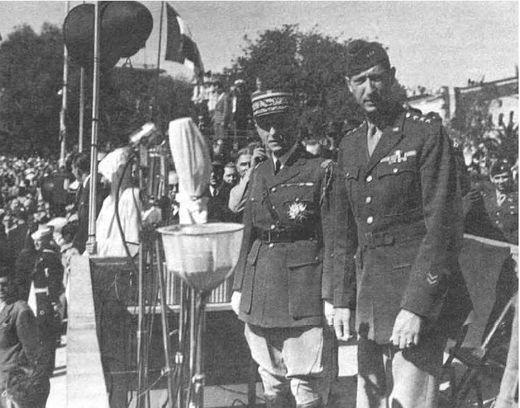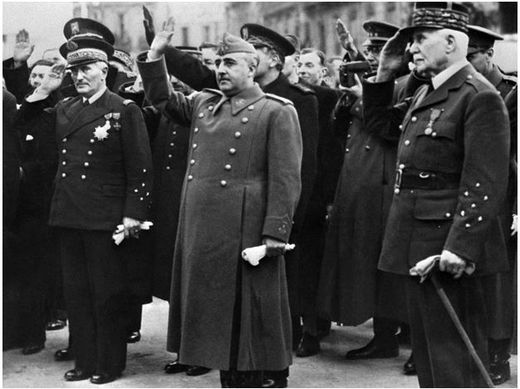
General Auguste Nogués is at the left.
Some US historians believe this plan stemmed from President Franklin D Roosevelt's antipathy towards Charles de Gaulle. Roosevelt saw him as a dictator-in-training and sought to prevent him from ruling post-Pétain. (Marshal Henri-Philippe Pétain led the pro-Nazi government of unoccupied France at Vichy,1940-44.) The argument that Roosevelt intended to establish universal democracy is compelling but wrong (1).
The US was concerned that France, although weakened by its 1940 defeat, might reject the plan, especially if its presidency went to De Gaulle, who had vowed to restore French sovereignty. It feared France might use its nuisance capacity as it had when it opposed pro-German US policies after the first world war. France would not have wanted to relinquish its empire, rich in raw materials and strategic bases. The US had long called for an open door policy for goods and investments in all colonial empires(2). The US relied on twin strategies: ignoring De Gaulle, and dealing with Pétain's regime with a combin ation of accommodation and toughness. It realised that Vichy, like the Latin American regimes dear to its heart, was more malleable than a government with broad popular support.
The US plan for a "Vichy-sans-Vichy" took shape. French elites supported the idea: they clung to the Vichy regime, which had restored privileges taken away by the pre-war republican government, and were eager to make a painless transition from German rule to the pax americana.

General Clark had Darlan sign an agreement on 22 November 1942 placing North Africa at the disposal of the US and making France a "vassal" state, subject to "capitulations"(4). The US assumed unprecedented rights over French territorial extensions in Africa, including overseeing troop movements; ports, airfields, military defences and munitions, communications networks and the merchant navy. The agreement also provided for US requisitions of goods and services; tax exemptions; extraterritorial rights; and US-determined military zones. Joint commissions would be responsible for law and order, current administration, censorship and economic policy.
Laval had sealed his fate by hoping for "a German victory" . Assisted by his son-in-law, René de Chambrun, a collaborationist corporate lawyer with dual US/French citizenship, Laval believed the US pledge that he would play a key role after a separate peace agreement, pitting Germany, Britain and the US against the Soviets, was reached. But US support for Laval was not compatible with French internal power struggles, and the separate peace proposal failed to take into account the Red Army's key role in crushing Hitler's Wehrmacht.
Darlan was assassinated by an anti-Vichyite with Gaullist connections on 24 December 1942. The US turned to General Giraud, who briefly served with De Gaulle as co-president of the French National Liberation Committee (CFLN), founded in 1943. After the battle of Stalingrad which marked the end of the German advance, Giraud was supported by senior Vichy officials, including Maurice Couve de Murville, overseas finance minister, who defected to the Allies in 1943. His supporters included industrialists such as Jacques Lemaigre-Dubreuil, a former member of the pro-fascist Cagoule group, who headed Lesieur oils and the Printemps department stores. Also onside were collaborationist bankers such as Alfred Pose, chief executive officer for the National Bank of Commerce and Industry.
Comment: As always, the financial elites of the world have no loyalty except to their own interests.
Pierre Pucheu was the next Vichy official to embrace the US option, joining Giraud in Algiers. No one personified the Vichy regime better than Pucheu. In 1941 he became Darlan's industry minister and then interior minister. He had served as a fundraiser for the fascist French People's Party . He also championed economic collaboration with Germany and anti-communist repression, working on behalf of the Nazi occupation (including selecting communist prisoners executed in 1941 in retaliation for the assassination of German officers, and establishing special sections - anti-communist tribunals).
Spurned by Giraud, Pucheu was imprisoned in May 1943 and sentenced to death; he was executed in Algiers in March 1944. This appeased the communists, whom Pucheu had martyred; but de Gaulle was also warning the US and Britain, and frightening those who expected US saviours to supplant the Vichy regime. In 1943 a police officer joked: "The French bourgeoisie always presumed that US or British soldiers would fight on its behalf if the Bolsheviks won"(5).
The US depicted De Gaulle as a right-wing dictator and a puppet of French communists and the USSR. But it had to abandon plans to impose the dollar in liberated territories. On 23 October 1944 the Allies officially recognised De Gaulle as head of the French government: the USSR had recognised France's true government two and a half years before. On 10 December 1944 France signed a treaty of alliance and mutual security with Moscow, to offset US power. De Gaulle described it in glowing terms(6).
Excluded from the Yalta conference in 1945 and dependent on the US, France became a key part of the US sphere of influence. But only vigorous resistance, internal and external, had saved it from becoming a US protectorate.



The USA did NOT "liberate" France, or Italy or any other countries with the defeat of Nazi Germany. The USA occupied these countries. NATO has always been the clever con-artist front man for that Occupation.